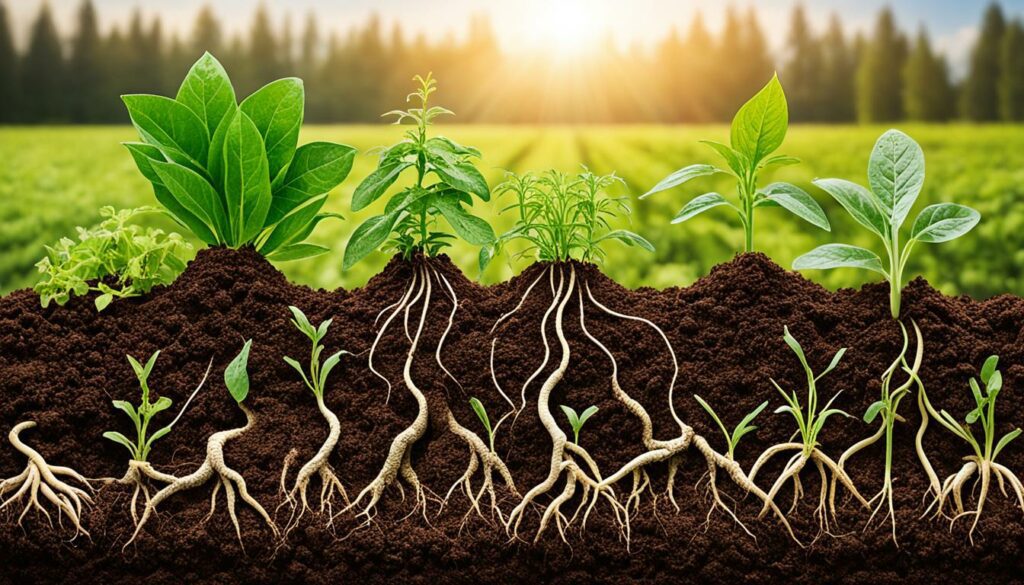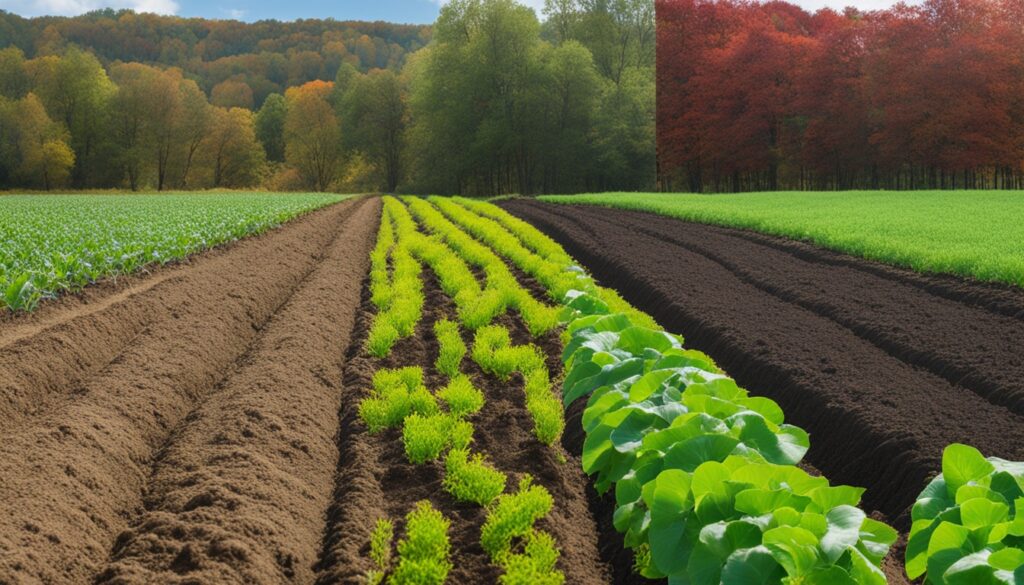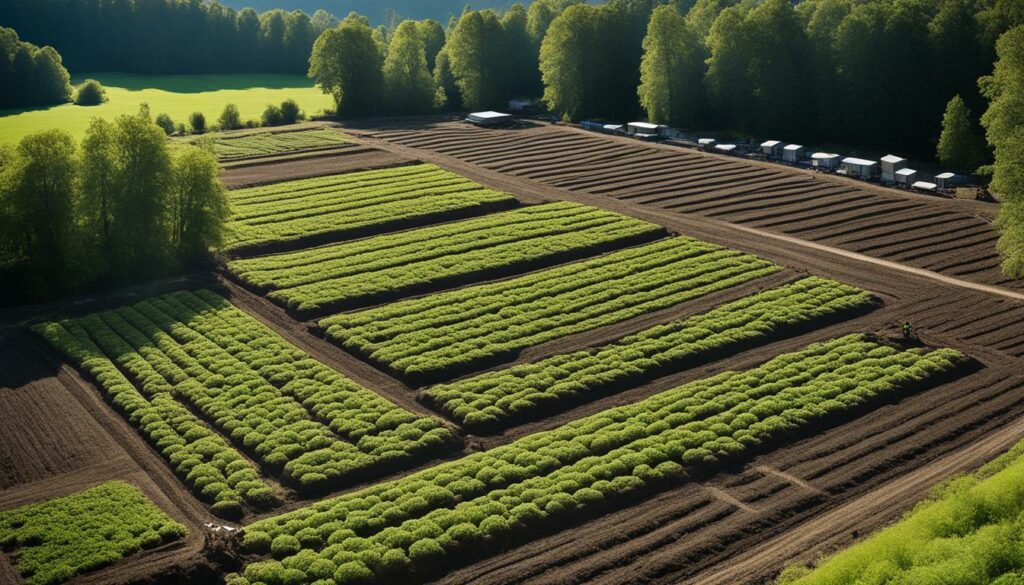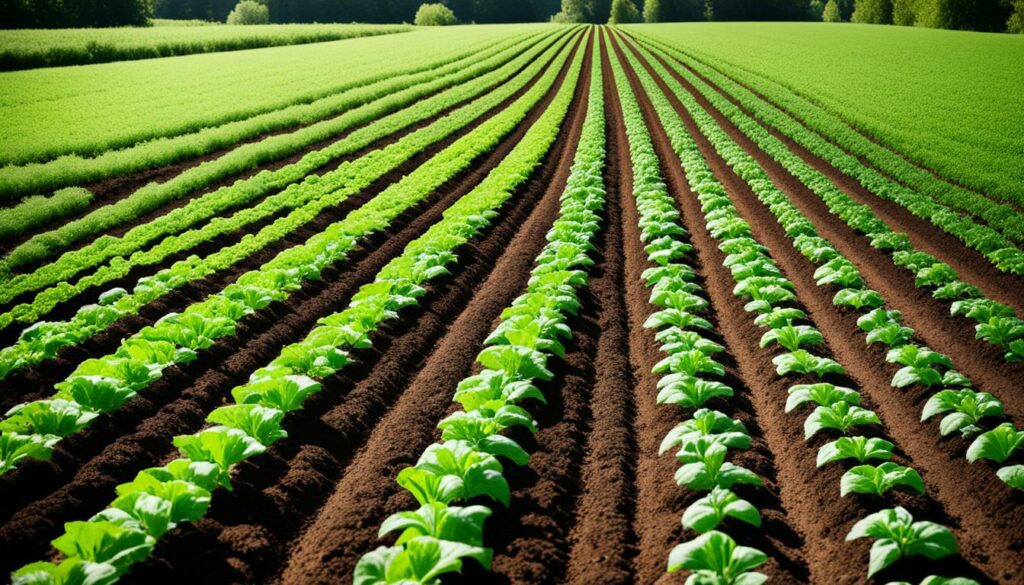Menu

Industrial farming causes soil to erode much faster than it can be remade. This means we need regenerative farming. It helps build back healthy soil and introduces new, whole-farm ways of thinking.
Regenerative farming is not just a method. It’s a whole new belief about how farming should work. It links everything together. The goal is to make the soil, nature, and people healthier. This idea isn’t new. Indigenous farmers have always focused on feeding the earth for future generations.
The Institute of American Indian Arts (IAIA) shows how to farm in a regenerative way. They use old techniques like creating waffle gardens and flood irrigation. Teresa Kaulaity Quintana at IAIA is a leader in this. She shows how to mix old farming ways with new learnings.
Regenerative agriculture is getting more attention as a way to fight climate change. It works to fix the big damage done by traditional farming. Regenerative soil practices are at its core, boosting the health of the ecosystem and helping to stop climate change. This method focuses on healthy soil and less machine use. This leads to better crops, stronger soil, and lots of helpful microbes.
Regenerative farming aims to heal the earth and build strong communities. It cuts down on artificial chemicals, reducing risks to people and helping farmers be more independent. This way of farming measures success not just by how much is produced, but by the joy and growth it brings. Farmers aim for a life where animals and the land support each other, moving nutrients, keeping water, and solving environmental issues.
Regenerative agriculture is not new; it comes from Indigenous farming that has been around for ages. These ancient methods show us how to heal ecosystems. Sadly, the number of Black farmers in the US has dropped a lot. Now, White farmers own most of the land. It’s important to remember Indigenous knowledge when working the land well. NRDC’s Arohi Sharma says we should learn from these old ways to help nature and society.
Today’s industrial farming is breaking down soil faster than it can rebuild naturally. But regenerative practices can mend this damage. They boost diversity and help communities thrive. They also teach us to work with nature, growing richer life above and below ground. This includes helping small farmers take care of the environment.
The root idea of regenerative farming is feeding the ecosystem. It works on adding variety and helping with climate change, offering a path to sustainable farming.
Regenerative agriculture aims to create a positive bond between people and the earth. It uses methods that protect the ecosystem and improve soil. This helps lessen the harm caused by normal farming.

Regenerative farmers care deeply about the delicate balance of ecosystems. They believe healthy soil is key for plants and animals to thrive. People have followed these principles for ages, keeping the earth fertile and protecting the environment.
Focusing on soil health is essential in regenerative farming. They avoid over-tilling and keep plants growing to make the soil rich. Notably, these methods prevent soil from washing away and improve soil life.
Regenerative farming cuts down on using chemicals. Less synthetic fertilisers and pesticides are used. This helps the land and its creatures stay healthy on their own. It also saves money and promotes a naturally balanced environment.
Regenerative farming is also about supporting communities. It ensures all farmers get fair access to resources and opportunities. This is crucial since most land in the US is owned by white farmers. Making these changes helps build a stronger economy that includes everyone.
Using regenerative soil methods has many important benefits. It helps keep our ecosystems healthy. By focusing on soil, these methods make it more fertile. They also increase the variety of plant and animal life. Plus, they help handle water and carbon in the environment well. This all leads to better farming and helps protect the planet.
Regenerative farming makes soil healthier and more fertile. This is a big change from the way big farms usually operate. They often harm the soil more than they help it. Regenerative ways, like using cover crops and not tilling as much, make soil better. They add more natural material to it and let helpful tiny life grow in it. This makes crops healthier and increases how much food we can grow. It’s a win for the earth and for our plates.
Regenerative agriculture is all about keeping life diverse and rich, both above and below the ground. It uses different plants in the fields each year and lets nature fight off bugs without chemicals. This makes sure the farm stays healthy and strong. It’s a key part of keeping the soil and farms going for a long time.
These soil methods help save water and put away harmful gases too. They do this by using less man-made stuff on the land. This helps stop water from getting dirty and makes it easier for plants to use. The soil can also hold water better, so there’s less to worry about in dry times. Adding more plants and letting them grow freely pulls in a lot of the bad gases from the air. This is a big deal in the fight against climate change.
| Benefit | Details |
|---|---|
| Soil Health and Fertility | Enhanced soil structure and increased organic matter leading to healthier crops and higher yields. |
| Biodiversity Promotion | Natural pest control and crop rotations supporting diverse plant and insect populations. |
| Water and Carbon Cycles | Reduced water pollution, improved water efficiency, and significant carbon sequestration potential. |
Soil erosion from big farms is a huge problem, happening much faster than new soil is made. This means we need to act now. By using regenerative farming methods, we can slow this erosion. These methods also make soil healthier and cut down on water pollution.
Cover cropping, reduced tillage, crop rotation, and composting are crucial for soil health. They help keep soil rich and full of life. Cover crops stop soil from washing away and add organic matter. Less tilling means more good bugs and plants in the soil.

| Technique | Benefit |
|---|---|
| Cover Cropping | Protects soil from erosion, improves organic content |
| Reduced Tillage | Minimizes soil disturbance, enhances microbial activity |
| Crop Rotation | Enhances soil nutrients, disrupts pest cycles |
| Composting | Enriches soil with organic matter, improves fertility |
Stopping the use of chemicals is key in regenerating soil. Not using these harmful things makes farms more diverse and tough. Regenerative farming also helps the economy and lets us all eat better. It helps both the land and the people living nearby.
Twice as many white farmers own land compared to farmers of colour in the US. But, new efforts aim to help all farmers get a fair chance. These efforts offer training and help to farmers who haven’t had much support. This is important for keeping regenerative farming going.
When we talk about sustainable soil management, we see the huge role healthy soil plays. Good soil health is key for strong crops and farming that can stand the test of time. Unlike older ways that hurt the soil, good practices make the soil and crops work together well.
A key point in taking care of the soil is looking at everything as a whole. This approach combines many methods to boost the soil’s well-being. Using things like cover crops, compost, and less tilling helps keep the soil healthy. This, in turn, stops soil from washing away and keeps nutrients where they should be.
Together, these steps do wonders for the soil. They also play a big part in making farming last for the long term.
Growing different things together and switching what’s planted where are also big parts of looking after the soil. By mixing up crops and planting different types together, we make the land more diverse. This helps the earth stay fertile and lowers the chances of pests and diseases. It does this without using chemicals.
| Practice | Benefit |
|---|---|
| Intercropping | Enhances biodiversity and natural pest control |
| Crop Rotation | Prevents soil depletion and reduces erosion |
Intercropping lets plants help each other grow in ways that need fewer chemicals. Crop rotation makes sure the soil’s food is well distributed. It also helps keep pests under control. So, these methods are good for the farm and the earth over time.
“Healthy soil is integral to achieving Sustainable Development Goals (SDGs) related to food security, environmental health, and economic stability.” – United Nations Food and Agriculture Organization
These good farming methods don’t just help the planet. They also help farmers make more money and boost rural areas. There are also plans at the country level to make sure everyone has a fair shot at farming success. This is especially to make up for past wrongs towards Black farmers and others who’ve not had equal opportunities in farming.
Regenerative farming focuses on revitalising the soil using organic methods. This improves the soil and supports tiny life. These steps help plants grow well without harming the environment. It’s key to use composting wisely and know how it fits into broader green goals.

I have found that adding stuff like composted manure, green manure, and bone meal makes soil better. They help the earth hold water and feed plants slowly. Their use is supported by big names like General Mills working towards eco-friendly farming on a large scale by 2030.
Making your own compost helps make the soil rich. It keeps the nature in the soil alive. Composting is great for keeping plant food in your farm, and adding mulch on top stops weeds and keeps the soil moist. It can also earn you money through carbon credits, making it even more worthwhile.
| Company | Acreage Committed to Regenerative Practices | Year Target |
|---|---|---|
| PepsiCo | 7 million acres | 2030 |
| Walmart | 30 million acres | N/A |
| VF Corporation | 1 million acres (U.S. Cotton Production) | N/A |
| General Mills | 1 million acres | 2030 |
Ecological farming methods are all about working with nature. They’ve been used by Indigenous communities for ages. The goal is to keep the land healthy and rich in plants and animals. In the United States, many farmers are now sharing how to farm in ways that help the Earth fight against climate change.
Using animals on farms can really help the soil and crops. This happens when animals and plants work together. For instance, rotating where animals graze each day can cut down on harmful gases. It also keeps rivers and lakes cleaner by reducing farm waste pollution. The animals’ waste helps the soil grow strong. Plus, animals eat the pests, so farmers don’t need to use as many chemicals.
Agroforestry mixes trees with farming and animals. This brings many good things. The land gets richer, more species of plants and animals thrive, and it stores more carbon from the air. Adding trees near farms can take a lot of harmful CO2 out of the air. So much, that it’s like taking thousands of cars off the road every year. This way to farm also keeps the animals healthier and lets the water stay clean.
| Method | Benefits | Statistics |
|---|---|---|
| Integration of Livestock |
|
|
| Agroforestry and Silvopasture |
|
|
Regenerative agriculture is changing how we see soil carbon storage in fighting climate change. The soil is a key carbon pool after the oceans. It plays a big role in reducing CO2 levels. With farming harming the soil the most, we must find better ways.

The European Commission aims to improve soils by 75% by 2030. This is urgent for facing climate change. Soil carbon is dropping in farms worldwide. This is bad for the carbon cycle.
Regenerative farming uses methods like cover crops and less tilling. It also keeps more types of plants. These practices increase soil carbon storage. In vineyards, these methods can store four times more carbon than other farms.
In 12,000 years, agriculture has released 133 billion tons of CO2 from soils. Some areas have lost 70% of their soil’s carbon. This highlights the need for actions to store carbon in the soil.
The IPCC dreams of 5.3 GtCO2/year of sequestration by 2030. With realistic steps, farmers could sequester 3.8 GtCO2 yearly. This would make agriculture a sector that removes more carbon than it emits.
This goal faces challenges, like much rented U.S. farmland. But, efforts like the Growing Climate Solutions Act offer hope. They work to bring more people into carbon markets. Also, the USDA is expanding programs that help soil and fight climate change.
Focusing on soil carbon sequestration could really help. It’s important for climate change resilience. Investing in regenerative agriculture is key. We can make a big impact this way.
Enhancing biodiversity is key in regenerative agriculture. It helps wildlife, pollinators, and the health of ecosystems. This way of farming helps many species and makes agricultural areas stronger and more sustainable.
Regenerative agriculture is big on helping wildlife and pollinators. It works to create environments where many species can live well. Imagine, wildlife numbers have dropped by 68% over the last 50 years. In places like the Caribbean and Latin America, the drop is as much as 94%. To make farming a place where nature thrives, practices like using less chemical and not ploughing as much are key.
Having many different plants is crucial in regenerative farming. Growing crops in turns helps bring in more kinds of plants and keeps the soil healthy. This method also helps lower pest numbers, needing less fertilizers, and makes the soil better. Sadly, half of the world’s topsoil has worn out over the past 150 years because of growing only one crop and using a lot of chemicals. Embracing many plants not only helps stop this damage but also makes a better home for lots of species and helps all the ecosystem get stronger.
| Metric | Impact |
|---|---|
| Wildlife Population Decline | 68% in the last 50 years |
| Biodiversity Recovery | Positive trends seen in species like humpback whales and bald eagles |
| Contribution of Monoculture Agriculture | Utilises 33% of the world’s land surface and 75% of freshwater resources |
| Clear-cutting for Agriculture Expansion | 50% of new agricultural land comes from deforested areas |
Regenerative agriculture helps plant life and homes for wildlife and pollinators. It’s a great way to farm that makes our land better and is good for the environment. For example, the Alexandre Family Farm has seen 240 bird species. They show how great this way of farming is. It’s more than just growing food, it’s about creating a balanced, strong, and helpful ecosystem.
Exploring agroecological methods shows they greatly help soil productivity in today’s farming. These practices help the soil become more fertile. Also, they work well with natural processes, which keeps farm systems sustainable and strong.
Organic fertilisation is a key practice in this. It uses natural materials to improve the soil’s nutrients. Organic fertilisers make the soil better and help more tiny creatures live in it. This is very good for the soil’s health over a long time.
Organic fertilisers are much better for the environment than synthetic ones. This matches what 60% of people in the world think. These people rely on farming for food and money (Porkka et al., 2017; Odusola, 2021).

Another important practice is using natural enemies to control pests. This way, we don’t have to use a lot of chemicals, which is a big issue now. These natural ways to control pests protect the environment. They help keep the natural order in balance and stop harm to the soil and other animals.
Then, there’s planting different crops together, or polycultures. This approach is great for the soil because it keeps adding new nutrients. It’s much safer for the soil and helps against pests without using harmful chemicals. Also, it helps manage the levels of nitrogen in the ground, which is very important for water protection.
With more and more people expecting to be on Earth by 2050, we need to farm carefully. Agroecological methods are a big part of farming in a way that’s good for the future. They help make farming strong against changes and keep the soil healthy and producing well.
Many studies show that these methods work and are very popular now. A special collection about these farming methods was read by many people. Adding whey-based hydrogel to the soil caught a lot of attention, showing that new ideas in farming are welcomed.
| Study | View Count | Citation Count |
|---|---|---|
| Soil Communities Study | 1890 | 3 |
| Whey-Based Hydrogel Amendment | 2767 | 11 |
“Agroecological farming practices are vital in sequestering carbon and improving overall soil quality. Their ecological validity is proven and documented across numerous studies and systems across the globe.” – Food and Agriculture Organization of the United Nations (FAO)
Focusing on agroecological methods for better soil is key. It not only keeps our food systems safe but also helps protect the planet. These ways of farming show we can grow lots of food without hurting the environment.
Regenerative agriculture boosts both the economy and society. It focuses on making farming sustainable and ethical. This new approach changes how we farm for the better.
One big plus of regenerative farming is less need for chemicals. This is good for the land and for crops. It also makes water cleaner and more available, helping during droughts.
For farmers, it improves finances. Farmers have less debt and risk but more yield and profit. This way of farming helps them stand on their own feet financially.
Community ties get stronger with this farming. Everyone is treated well, including those who were not treated fairly before. Plus, working together and forming groups boosts their power in markets.
Studying successful regenerative agriculture stories shows how powerful these methods can be. General Mills is leading the way by aiming to improve one million acres using regenerative agriculture by 2030.
This goal highlights key regenerative agriculture ideas. These include causing little harm to the soil, growing different types of crops, and keeping the soil covered, among others.
Seeing real results from these ideas is eye-opening. For example, after more than three decades of work, prairie soil is now lighter, holds more carbon, and supports a lot more life than before.
However, moving to regenerative farming isn’t easy. It means facing some failures along the way. But the success stories are many, and they show the real progress that can be made with the right effort.
Take Laureano, a farmer who improved his maize harvest a lot. Now, he grows two big ears of maize on each plant, up from one smaller ear before. He’s even managed to avoid tough work on a sugarcane farm by using smart farming methods.
Laureano’s using natural ways to make his soil better. This not only benefits him but also shows how regenerative farming helps the land heal. Such stories demonstrate the good that can come from these efforts.
Many small farmers globally, around 15 million, are starting to use regenerative methods. By sharing what works for free, they’re creating a knowledge network among farmers everywhere.
There are also efforts to start markets for natural services and to push for actions that help the climate. Doing simple things at home, like wasting less food and gardening smartly, can also help a lot.
Regenerative agriculture is about helping the land thrive. It focuses on making soil, nature, and local areas better. This care ensures that the earth stays healthy for those who come after us.
It helps by storing carbon in the ground. When we plant cover crops and disturb the soil less, we keep carbon out of the air. This lowers the CO2 in the atmosphere and slows down climate change.
Indigenous people have used regenerative farming for years. They used methods like waffle gardening and flood irrigation. These have been proven effective over time, as seen in the work of places like the Institute of American Indian Arts.
The main ideas are to work with nature, protect the soil, and cut back on harmful chemicals. Also, it’s about helping local areas and the people who live there. These steps are good for both nature and communities.
These methods make the soil and crops healthier. They increase what we can grow, help more plants and animals live there, and manage water and carbon better. This helps fight climate change and farming that lasts for a long time.
People use cover crops, till the soil less, change what they plant, and recycle waste. By doing this, the soil gets better, more carbon is kept, and crops grow strong.
It’s about using a smart plan that covers everything. Activities like growing different crops together and changing what’s planted keep the land healthy without needing a lot of chemicals.
To fix the soil, farmers add natural things and use natural ways to help plants grow. This not only makes the soil better but also helps plants and the things that live in the soil.
We farm by mixing animals with crops, grow trees on the farm, and protect from pests naturally. These methods make the farm naturally strong and the soil rich.
By growing many different plants, the farm becomes a home for all kinds of life. Animals and insects find a place to live, which makes the farm better and helps it last for a long time.
These practices help farmers earn more and be less dependent on chemicals. They also make areas stronger and bring people together. This is good for everyone and helps those who need it most.
Yes, many places have shown how regenerative farming works. The results are more food, happier land, and fairer systems. These stories show the way to a better future for food and nature.